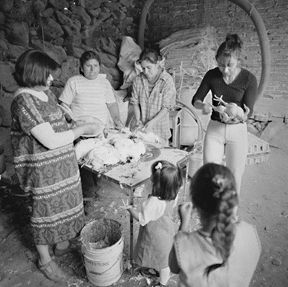Free lesson plans for traveling exhibit will enhance understanding of Northeast migrant farmworkers' essential role
By Susan S. Lang
Who picks and packages the fruits and vegetables in supermarkets? To learn more about the faces and lives behind the produce we eat, teachers and youth leaders can obtain free teacher resources and lesson plans developed by Cornell University on migrant farmworkers in the northeastern United States.
The lesson plans are designed to enhance understanding by students who visit the new traveling exhibit, Coming Up On the Season: Migrant Farmworkers in the Northeast, formally opening November 17 at the Hammond Museum in North Salem, N.Y. It moves to the Tompkins County Museum, Ithaca, in February 2002, to the New Jersey Historical Society, Newark, in October 2002, and to several other sites in the Northeast in 2003. The activities and lessons are consistent with the New York State Learning Standards in language arts and social studies.
Teachers planning to visit the 1,500-square-foot exhibit can obtain free printed educational materials from the museums. The materials are geared for three levels: grades 2 to 5, 6 to 8 and 9 to 12.
The exhibit, both in English and Spanish, traces the path of fruits and vegetables and the lives of the people who grow and harvest them in six Northeast regions. Based on five years of fieldwork and documentation and developed by the Cornell Migrant Program, the exhibit includes more than 150 photographs, almost 100 artifacts, two video installations, more than 100 interviews and several interactive activities.
"Behind supermarket shelves is a vast world invisible to most of us. Even in our mechanized world, having fresh, unblemished produce still means that someone has to pick it, or bunch it, or wash it or pack it," says Herb Engman, director of the Cornell Migrant Program. He points out that the Northeast uses a higher percentage of migrant labor than any other area of the country. Support for the exhibit has been provided by the National Endowment for the Humanities and the New York State Council on the Arts, among other funders. For more information, contact Engman at (607) 255-2536 or hje1@cornell.edu .
Media Contact
Get Cornell news delivered right to your inbox.
Subscribe